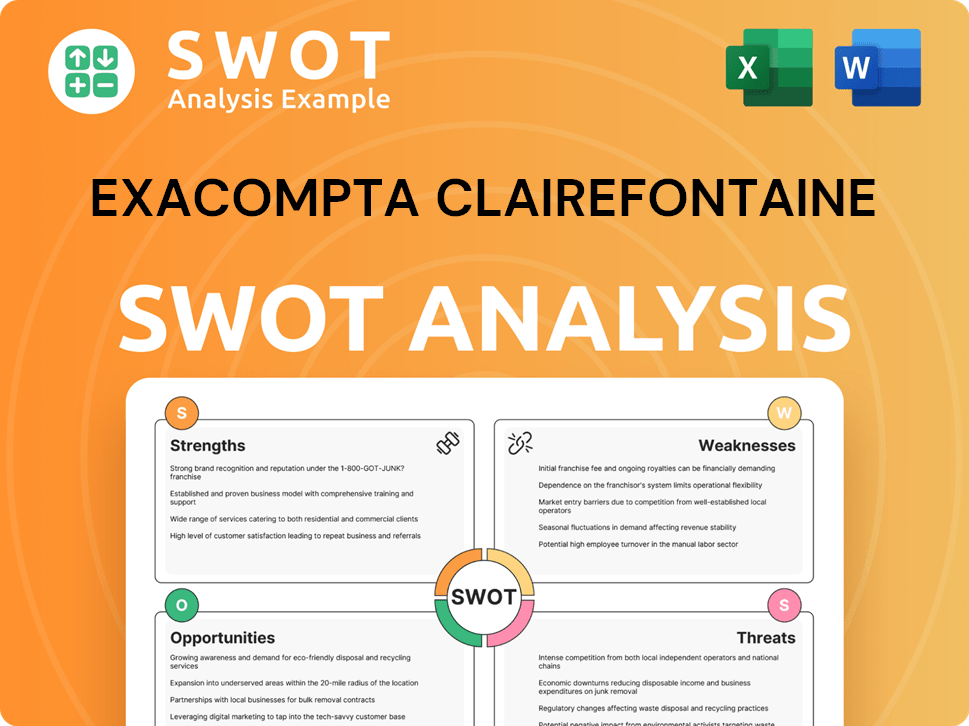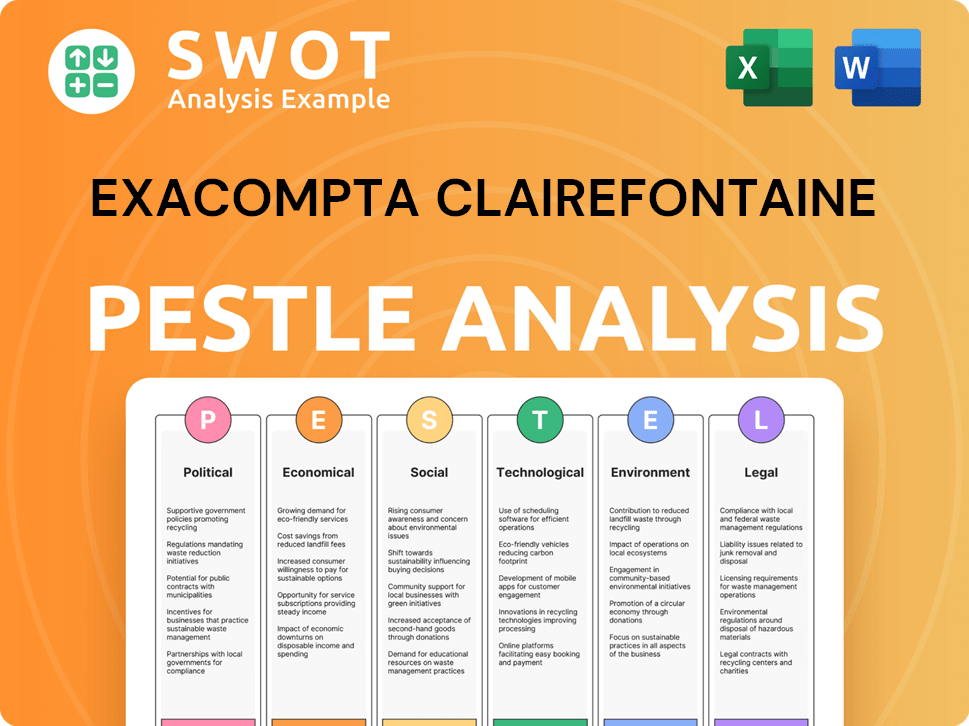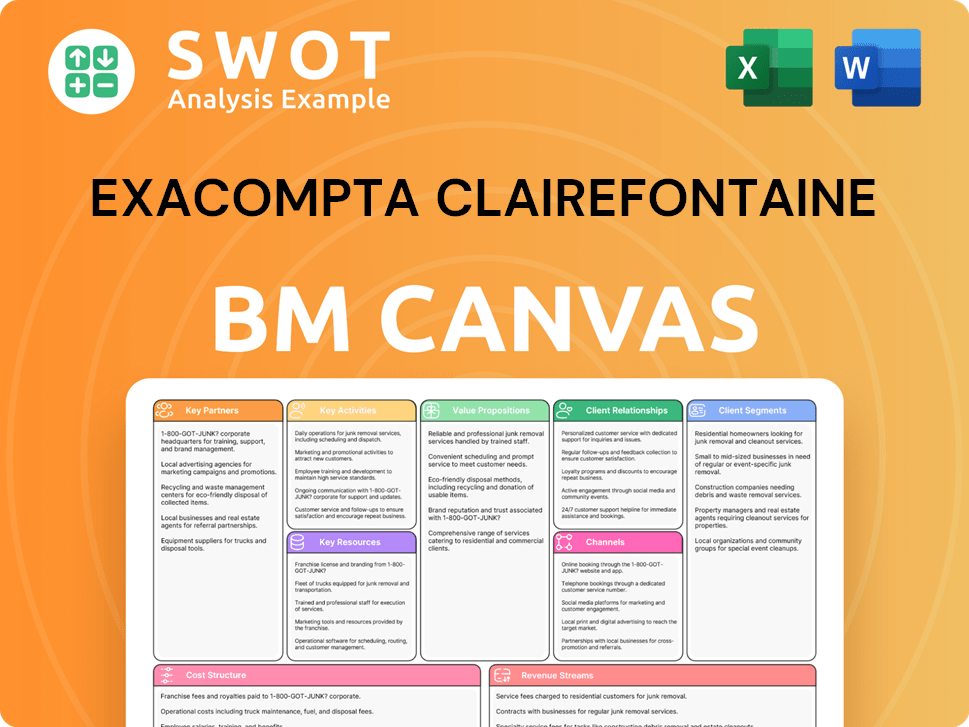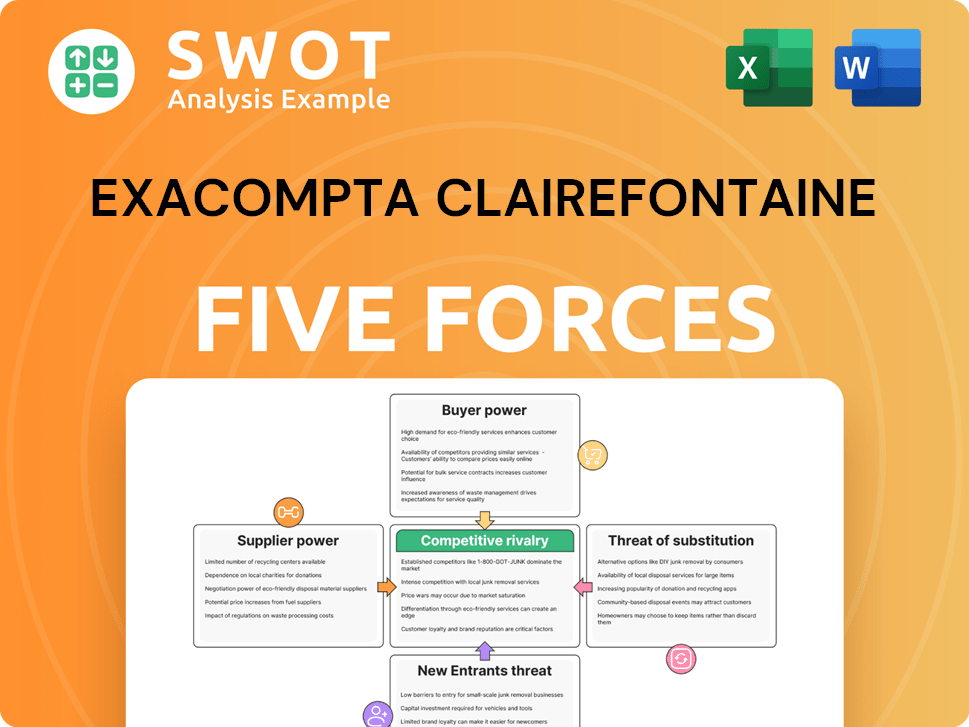Exacompta Clairefontaine Bundle
Who Really Calls the Shots at Exacompta Clairefontaine?
Understanding the ownership structure of a company is paramount for investors and strategists alike. The Exacompta Clairefontaine SWOT Analysis reveals how this French stationery company's ownership influences its strategic direction and market position. From its humble beginnings to its current status, the evolution of Exacompta Clairefontaine's ownership tells a compelling story of adaptation and growth.

Delving into the ownership of Exacompta Clairefontaine, a prominent French company, offers a window into its corporate governance and future prospects. Knowing who owns Exacompta Clairefontaine, from its founding families to any institutional investors, is crucial for grasping its strategic priorities. This exploration will illuminate the key players and significant shifts that have shaped this stationery company's journey, revealing how ownership impacts its operations and market influence.
Who Founded Exacompta Clairefontaine?
The story of Exacompta Clairefontaine begins with the establishment of Papeteries de Clairefontaine in 1858 in Etival-Clairefontaine, France. The company was founded by Jean-Baptiste Bichelberger. This marked the inception of a long-standing legacy in paper manufacturing.
While specific details on the initial ownership structure are not widely available in public records, the early ownership likely involved Bichelberger and possibly other local investors. This setup was typical of industrial enterprises during that era. The focus was on establishing a solid operational framework for paper production.
Early agreements would have centered on setting up the paper mill, including acquiring machinery, sourcing raw materials, and establishing distribution channels. Initial funding probably came from private sources, potentially involving local investors or a close network of associates. The company's history reflects a foundational ownership rooted in family enterprise.
The company's origins trace back to 1858 with the establishment of Papeteries de Clairefontaine.
Jean-Baptiste Bichelberger founded the company.
Early efforts were on setting up the paper mill's operations.
Early ownership was likely centered within the founding family and potentially local investors.
Initial capital was likely raised through private means, possibly involving local investors.
The founding team aimed for high-quality paper production and sustainable practices.
The early ownership structure of Exacompta Clairefontaine, a prominent French company, was likely characterized by family involvement and local investment, reflecting the business practices of the 19th century. The focus was on building a sustainable paper manufacturing enterprise, which laid the groundwork for the company's enduring presence in the stationery company market. For a deeper dive into the company's past, check out this Brief History of Exacompta Clairefontaine.
- The company was founded in 1858 by Jean-Baptiste Bichelberger.
- Initial ownership was likely concentrated within the founding family and local investors.
- Early agreements focused on establishing paper mill operations and securing resources.
- The vision for high-quality paper production guided the company's early growth.
Exacompta Clairefontaine SWOT Analysis
- Complete SWOT Breakdown
- Fully Customizable
- Editable in Excel & Word
- Professional Formatting
- Investor-Ready Format

How Has Exacompta Clairefontaine’s Ownership Changed Over Time?
The evolution of Exacompta Clairefontaine's ownership reflects a shift from a closely held, family-run business to a publicly listed entity. This transition involved the introduction of the company on the Paris Stock Exchange, broadening its shareholder base beyond the founding families and initial private investors. This move was a crucial step in its history, allowing for increased capital and a wider investor pool.
As a publicly traded company, Exacompta Clairefontaine's shares are now held by a variety of stakeholders. These include institutional investors, individual shareholders, and the founding families. The Clairefontaine family and related entities continue to hold a significant stake in the company, which is common among long-standing European industrial firms. Major institutional investors, such as mutual funds and investment firms, also own notable percentages of the shares. The specific percentages held by these entities are subject to change based on market activity and are detailed in financial filings.
| Ownership Aspect | Details | Impact |
|---|---|---|
| Initial Ownership | Primarily family-owned, with limited external investors. | Focused on long-term vision and family values. |
| Public Listing | Introduction on the Paris Stock Exchange. | Increased capital, broader investor base, and enhanced visibility. |
| Current Ownership Structure | Mix of family holdings, institutional investors, and individual shareholders. | Balances family influence with public market demands, impacting strategic decisions. |
The current ownership structure of Exacompta impacts its strategic decisions. The presence of diverse stakeholders requires balancing the long-term vision of the Clairefontaine family with the performance expectations of the public market. The company's annual reports and financial disclosures provide detailed insights into the shareholding composition, including significant investors. This shift has influenced the governance structure, affecting decisions related to expansion, acquisitions, and financial targets. Understanding the Exacompta Clairefontaine ownership structure is key to understanding the company's direction.
Exacompta Clairefontaine has evolved from a family-run business to a publicly traded company, with a diverse shareholder base. The Clairefontaine family maintains a significant stake, influencing the company's strategic direction. Institutional investors also play a key role in the ownership structure.
- Public listing expanded the investor base.
- Family influence remains significant.
- Institutional investors hold notable shares.
- Annual reports provide ownership details.
Exacompta Clairefontaine PESTLE Analysis
- Covers All 6 PESTLE Categories
- No Research Needed – Save Hours of Work
- Built by Experts, Trusted by Consultants
- Instant Download, Ready to Use
- 100% Editable, Fully Customizable

Who Sits on Exacompta Clairefontaine’s Board?
The Board of Directors of Exacompta Clairefontaine, a prominent French company, oversees the strategic direction and governance of the organization. The board's composition typically includes representatives from the founding families, major shareholders, and independent directors. This structure aims to balance family interests, shareholder value, and independent oversight, ensuring robust corporate governance practices. Detailed information about the current board members and their affiliations can be found in the company's official annual reports and corporate governance statements.
The presence of independent directors on the board is crucial for ensuring objective decision-making and adherence to best practices. These directors bring diverse expertise and perspectives, contributing to the overall effectiveness of the board. The board's decisions significantly impact the company's strategic initiatives, including major investments, sustainability efforts, and corporate development. Understanding the board's composition is key to grasping the dynamics of Exacompta Clairefontaine's operations and future prospects. For more insights, you can read about the Growth Strategy of Exacompta Clairefontaine.
| Board Role | Responsibilities | Key Focus Areas |
|---|---|---|
| Chairman | Leads board meetings, ensures effective governance. | Strategic direction, corporate governance. |
| CEO | Manages day-to-day operations, implements strategy. | Operational performance, financial results. |
| Independent Directors | Provide objective oversight, ensure compliance. | Risk management, audit, and compensation. |
The voting structure for Exacompta Clairefontaine generally follows a one-share-one-vote system. However, it's possible that long-term shareholders, particularly those from the founding families, may hold shares with special voting rights, which is a common practice in French companies. Such arrangements can grant these shareholders greater influence. There have been no widely reported proxy battles in recent years, suggesting a stable governance environment. The board and voting power dynamics are critical in shaping the company's strategic direction. The company's ownership structure and board composition are key elements in understanding the overall strategy of the Exacompta Clairefontaine brand.
The Board of Directors includes family representatives, major shareholders, and independent directors.
- Independent directors ensure objective decision-making.
- Voting typically follows a one-share-one-vote system.
- Long-term shareholders might have special voting rights.
- Board composition influences strategic direction.
Exacompta Clairefontaine Business Model Canvas
- Complete 9-Block Business Model Canvas
- Effortlessly Communicate Your Business Strategy
- Investor-Ready BMC Format
- 100% Editable and Customizable
- Clear and Structured Layout

What Recent Changes Have Shaped Exacompta Clairefontaine’s Ownership Landscape?
Over the past few years (2021-2024), Exacompta Clairefontaine has been adapting to industry shifts. The company's focus on sustainability, including eco-friendly product development and certifications, aligns with the growing investor interest in ESG factors. This approach can draw in investors who prioritize environmental, social, and governance issues.
The stationery sector has seen trends like increased consolidation and digital transformation. While the French company, Exacompta Clairefontaine, has maintained its core business, it has likely adjusted through internal efficiencies and product diversification. The Clairefontaine family probably still holds a significant influence. Any major mergers or acquisitions would be publicly announced and would significantly change the ownership landscape. Public statements and analyst reports provide insights into future ownership changes, succession planning, or potential strategic partnerships. No major announcements regarding privatization or a new public listing have been widely reported as of early 2024.
| Aspect | Details | Impact |
|---|---|---|
| Sustainability Initiatives | Commitment to sustainable forestry and eco-friendly products. | Attracts ESG-focused investors, potentially increasing the company's value. |
| Industry Trends | Increased consolidation and digital transformation. | Requires internal efficiencies and product diversification to stay competitive. |
| Ownership Stability | Likely significant influence from the Clairefontaine family. | Suggests a focus on long-term growth within its established market. |
The emphasis on Environmental, Social, and Governance (ESG) factors is a key trend. This can attract investors interested in sustainable practices. This focus can lead to increased investment and positive brand perception.
The company adapts to market changes through internal efficiencies. Product diversification is another strategy to remain competitive. These adjustments help Exacompta maintain its position in the market.
The Clairefontaine family's continued influence suggests a stable outlook. This stability supports long-term growth strategies. It provides confidence in the company's direction.
The company's consistent performance indicates a stable ownership outlook. This suggests a focus on long-term growth. The company aims to maintain its market position.
Exacompta Clairefontaine Porter's Five Forces Analysis
- Covers All 5 Competitive Forces in Detail
- Structured for Consultants, Students, and Founders
- 100% Editable in Microsoft Word & Excel
- Instant Digital Download – Use Immediately
- Compatible with Mac & PC – Fully Unlocked

Related Blogs
- What are Mission Vision & Core Values of Exacompta Clairefontaine Company?
- What is Competitive Landscape of Exacompta Clairefontaine Company?
- What is Growth Strategy and Future Prospects of Exacompta Clairefontaine Company?
- How Does Exacompta Clairefontaine Company Work?
- What is Sales and Marketing Strategy of Exacompta Clairefontaine Company?
- What is Brief History of Exacompta Clairefontaine Company?
- What is Customer Demographics and Target Market of Exacompta Clairefontaine Company?
Disclaimer
All information, articles, and product details provided on this website are for general informational and educational purposes only. We do not claim any ownership over, nor do we intend to infringe upon, any trademarks, copyrights, logos, brand names, or other intellectual property mentioned or depicted on this site. Such intellectual property remains the property of its respective owners, and any references here are made solely for identification or informational purposes, without implying any affiliation, endorsement, or partnership.
We make no representations or warranties, express or implied, regarding the accuracy, completeness, or suitability of any content or products presented. Nothing on this website should be construed as legal, tax, investment, financial, medical, or other professional advice. In addition, no part of this site—including articles or product references—constitutes a solicitation, recommendation, endorsement, advertisement, or offer to buy or sell any securities, franchises, or other financial instruments, particularly in jurisdictions where such activity would be unlawful.
All content is of a general nature and may not address the specific circumstances of any individual or entity. It is not a substitute for professional advice or services. Any actions you take based on the information provided here are strictly at your own risk. You accept full responsibility for any decisions or outcomes arising from your use of this website and agree to release us from any liability in connection with your use of, or reliance upon, the content or products found herein.